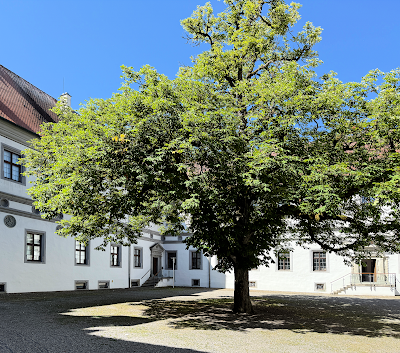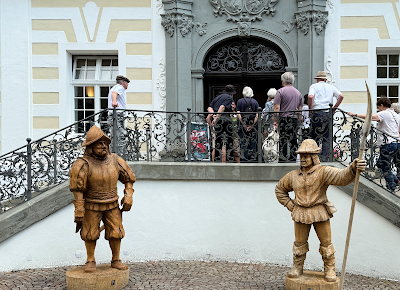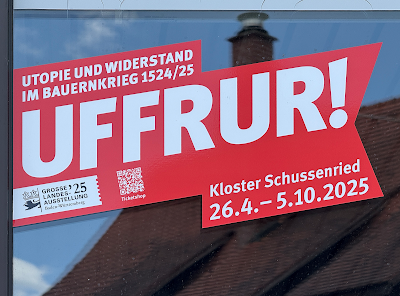Again, this was not for Martin Heidegger, who was born in Meßkirch, but for a visit to the local castle. It is the first regular four-winged castle north of the Alps in the Renaissance style.

|
| The castle square with the church |

|
| The east front of the castle |

|
| The castle courtyard: "It was the chestnut and not the linden." |

|
| A line of sight from the castle courtyard to the entrance of the church |

|
| The missing north wing |
The Meßkirch castle contains the oldest Renaissance banquet hall in Germany, measuring 30 × 9.60 meters, with its original cantilevered wooden coffered ceiling.
Schussenried Monastery is a former imperial abbey located in Upper Swabia
in the town of the same name.
The Premonstratensian canons lived there from 1183 until the Napoleonic secularization in 1803.
Once we arrived at Schussenried, we first stopped for lunch at the
Gasthaus zum Klosterhof, i.e., at the "inn inside the monastery
courtyard," which is located outside the former monastery.
From there, it was not far to the convent building.
On the way, we noticed St. Magnus Church, which now serves as the Catholic parish church.
The premises of the former monastery are now used as event and exhibition spaces.

|
|
Folks were eagerly streaming in, but neither the lansquenet nor did the peasant control the flow of people. |

|
| The word of God remains forever. |
And still there was more to see, because our group first visited the former
baroque library of the monastery.
Today, you won't find any books, because they were all sold at a profit during the secularization period. It is now all painted canvas.
The highlight of the library is the painted ceiling with Christian and mythological depictions. For example, Aeneas, with his head raised high and holding his son Ascanius by the hand, carries his father Anchises on his shoulders, leading his family and companions out of the burning city of Troy.
Discover more well-known scenes.
One preacher scolds those who indulge in alcohol.
Unbelief or the misinterpretation of the Scripture are offenses that this preacher vigorously refutes.
And for him, it is entirely unacceptable when unbelievers (Turks?) play with the dove of the Trinity. The preacher's expression is one of horror.
The map shows the full extent of the unrest, which stretched from Stühlinger in the southwest to Thuringia in the north. When I asked why Bavarian territories were not affected by the peasant uprisings, I received unconvincing answers.
Most peasants felt burdened and weighed down, like this one. It is a sculpture from the town hall in Überlingen, where peasants from the manorial estate had to pay their taxes in either money or goods in kind. Now, in April 1524, the farmers on the Upper Rhine no longer tolerated their grievances.
In July 1525, the battles of the Peasants' War were threateningly close to
the city of Nuremberg when Dürer had a nightmare about a flood. On the night
of June 8, he had a dream in which the landscape around him was utterly
devastated by falling masses of water. He added a detailed description to
his picture.
At the center of the occupants of the small boat stands the crowned
St. Ursula, who was murdered by Huns on her way to Cologne together with 11,000 of her
virgin companions. Pope
Siricius
and a bishop, adorned with the tiara and bishop's miter, and dressed in
magnificent golden robes, sit in the boat. What a contrast to the serfs!
Here we see the difference in social status again. The
Virgin Mary
spreads her cloak protectively over humanity. On the right, the privileged
side, stands the clergy led by the pope; opposite them are the emperor,
nobles, citizens, and peasants.
Hakenbüchse (hook gun). A hook like this on the underside of such
guns cushioned the recoil somewhat. About one in five farmers owned a hook
gun.
The leaflet notes that peasants burned and looted a total of 72 monasteries
and castles before April 1525. The Black Forest alone accounted for 46 of
these, including Schussenried.
Today, you won't find any books, because they were all sold at a profit during the secularization period. It is now all painted canvas.
The highlight of the library is the painted ceiling with Christian and mythological depictions. For example, Aeneas, with his head raised high and holding his son Ascanius by the hand, carries his father Anchises on his shoulders, leading his family and companions out of the burning city of Troy.
Discover more well-known scenes.
I was rather impressed by four groups of plaster figures, two of which
were facing each other. At first, I assumed that the tall statues
holding writings in their hands were the four apostles. Far from it,
they are preachers addressing four human sins.
Unbelief or the misinterpretation of the Scripture are offenses that this preacher vigorously refutes.
And for him, it is entirely unacceptable when unbelievers (Turks?) play with the dove of the Trinity. The preacher's expression is one of horror.
After visiting the library, we took the long staircase to our actual
destination. I have written about the Peasants' War on various
occasions in blogs, for example,
here
and
here. I will just present some exceptional exhibits below.
The map shows the full extent of the unrest, which stretched from Stühlinger in the southwest to Thuringia in the north. When I asked why Bavarian territories were not affected by the peasant uprisings, I received unconvincing answers.
Most peasants felt burdened and weighed down, like this one. It is a sculpture from the town hall in Überlingen, where peasants from the manorial estate had to pay their taxes in either money or goods in kind. Now, in April 1524, the farmers on the Upper Rhine no longer tolerated their grievances.

|
| Dream vision. Watercolor from the Albrecht Dürer art book, Nuremberg, June 1525 |

|
| St. Wendelin, Upper Swabian workshop, Wurzach 1520 |
An ideal world in which
St. Wendelin, the patron saint of farmers and shepherds, is depicted. His neat, peasant
clothing, beard, and hairstyle contrast with the poor lives of his admirers.

|
|
Hans Herlin, St. Ursula and her companions. Colored lime wood, Memmingen, around 1510 |

|
|
From an Augsburg workshop, Madonna of the Protective Cloak in a Field of Wheat, stained glass, around 1520 |

|
| Iron, oak wood. Southern Germany, late 15th century. |

|
| Woodcut by Erhard Schön, 1525 |

|
| Stained glass, Constance 1528-1550 |
The first battle of the Peasants' War was a disaster for the rebels. When
the imperial army encountered the peasants west of Leipheim on April 4,
1525, they fled almost without putting up a fight. During their attempted
escape, thousands were killed or drowned in the Danube River. Days later,
the survivors were still occupied with burying their dead.
Hans Dorn, the commander of the princely alliance, reported to the city of
Esslingen on April 7, "I would like to inform you that on Tuesday we stabbed
about 500 and drowned about 400 in the Danube. And on Friday, the peasants
loaded the dead onto carts and took them to a field near Leipheim, where a
pit had been dug by the road, and all the dead were buried in it."

|
|
In 1994, 26 of the victims of the Battle of Leipheim were
discovered, and their remains were recovered. |

|
| Peasant? Brush drawing, Wittenberg, 1540-1550 |

|
| Graphic by Hubert Hoffmann, Sassbach, 1990. |
In 1990, citizens' initiatives used the poster to commemorate their successful
protest against the planned nuclear power plant in Wyhl. The central figure
comes from a satirical text from 1522, but the original word "Freyheit
(freedom)" on the banner was changed to "mir lehre uns z'wehre (we
learn to defend ourselves)". The figure with the new slogan places the
citizens' initiative in the tradition of the rebels of 1525.

|
| No upheaval in the restroom ... advises Götz von Berlichingen. |
*



















No comments:
Post a Comment